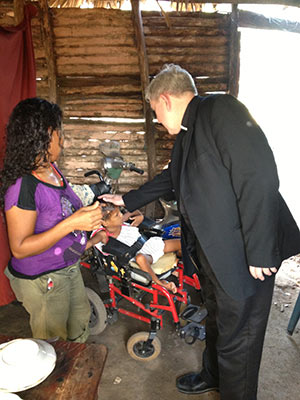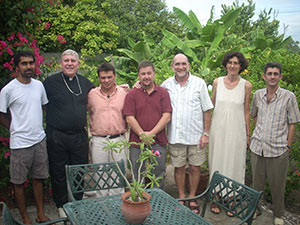Dirt floors in homes smaller than a two-car garage. Thatched roofs that leak water and store bugs. Spotty or no electricity or running water. Archbishop Jerome E. Listecki described the abject poverty he saw in some areas of the Dominican Republic during his trip, Oct. 18-22, to La Sagrada Familia, the Milwaukee Archdiocese’s sister parish.
 Archbishop Jerome E. Listecki blesses Lady, a 16-year-old girl suffering from a physical condition, on Saturday, Oct. 20 in Ganadero, Dominican Republic, during his first trip to the archdiocese’s sister parish, La Sagrada Familia. (Submitted photos courtesy Jerry Topczewski)The archbishop also saw parish projects that are “elevating the living conditions” of the people, where La Sagrada Familia Parish replaced thatched roofs with tin, built latrines and helped people grow their own food, he described to archdiocesan staff upon his return.
Archbishop Jerome E. Listecki blesses Lady, a 16-year-old girl suffering from a physical condition, on Saturday, Oct. 20 in Ganadero, Dominican Republic, during his first trip to the archdiocese’s sister parish, La Sagrada Familia. (Submitted photos courtesy Jerry Topczewski)The archbishop also saw parish projects that are “elevating the living conditions” of the people, where La Sagrada Familia Parish replaced thatched roofs with tin, built latrines and helped people grow their own food, he described to archdiocesan staff upon his return.
Surprised by level of poverty
“He was surprised by the level of poverty of the people and the extensiveness of the work in La Sagrada Familia,” wrote Fr. Juan Manuel Camacho, a member of the Community of St. Paul appointed associate pastor of La Sagrada Familia shortly after he was ordained a priest for the Milwaukee Archdiocese in May. “At the same time, he was very happy to see that the Archdiocese of Milwaukee is doing great things for the evangelization of the people here in the Dominican Republic.”
“I would like to take all the juniors and seniors in our high schools, put them in my pocket, and take them down to La Sagrada Familia so that they can appreciate what’s happening there and they can appreciate what they have here,” Archbishop Listecki told archdiocesan staff.
The visit was intense, according to Fr. Ricardo Martin Pinillos, part-time administrator of Sacred Heart Parish in Racine and a member of the Community of St. Paul, an archdiocesan association of the faithful in charge of La Sagrada.
‘Very intense 5 days’
Fr. Pinillos arrived in the Dominican Republic with Archbishop Listecki and Jerry Topczewski, the archbishop’s chief of staff, on Thursday, Oct. 18, beginning “a very intense five days,” he wrote in a Sacred Heart Church bulletin following the trip where he and other members of the Community of St. Paul celebrated Mass with Archbishop Listecki at La Sagrada and some of its oustations, showed him the parish’s ministries, including the health center, two nutritional centers, bakery, sewing center and computer lab, and visited with the youth group, catechists, Haitians, and prisoners at the jail.
“He told us he was impressed by the extensiveness of the work,” Fr. Pinillos wrote in an email to your Catholic Herald. “I believe he meant extension graphically, the people we reach (30,000 people), but especially the number of projects going on.”
Archbishop received warm reception
Fr. Pinillos said the people received the archbishop warmly, as they’ve received the groups that have visited from Milwaukee during parish trips or through the World Missions Office.
“At the places where we had Mass, in the visits to the different projects, or in some communities where we could just stop for a short time, everybody expressed
Help La Sagrada Familia Parish You’ll have the opportunity to participate in a special collection for La Sagrada Familia at parishes throughout the archdiocese on Saturday, Dec. 8 and Sunday, Dec. 9. |
their affection and respect, and they listened to what the archbishop had to tell them,” Fr. Pinillos wrote. “The archbishop’s message was that we witness the love of God by the way we love one another; that we are united as family in our witnessing to this love; and that, because we are family, he felt that La Sagrada Familia was an extension of what we do in Milwaukee: he would say, ‘I belong to you and you belong to me.’”
Fr. Pinillos said people at La Sagrada love their priests and bishop, and convey that love clearly after Mass by giving them “a thousand hugs, kisses, etc.” They treated the archbishop no differently.
“It was very nice to see all these people surrounding the archbishop after Mass,” he wrote, pointing it out as one of the most memorable moments from the archbishop’s trip.
Fr. Marti Colom, pastor of La Sagrada Familia Parish, said the people are used to receiving visitors from Milwaukee, and were delighted to have the archbishop with them for a few days.
Dominicans were happy to show achievements
“Yes, after Mass many people would go to greet him effusively, which was very nice,” Fr. Colom wrote in an email to your Catholic Herald. “They were happy to show him their achievements: their chapels, the successful programs in which they participate (the nutritional center, the parish’ health center, the parish’ bakery, etc.) as well as to share with him their struggles.”
Haitian ministry growing
Fr. Camacho, who is involved in the parish’s Haitian ministry – about 3,500 Haitian immigrants live in the 22 villages surrounding Sabana Yegua, the parish’s largest town – said the people made Archbishop Listecki feel at home.
“He felt connected with the people of La Sagrada Familia and loved them….” Fr. Camacho wrote. “People from Milwaukee are very much welcome here because Archbishop Jerome E. Listecki’s stands with, left to right, Denny Jacob, who is considering priesthood; Fr. Juan Manuel Camacho, associate pastor of La Sagrada Familia; Fr. Ricardo Martin Pinillos, administrator of Sacred Heart Parish, Racine; Fr. Pere Cane-Gombau, member of the Community of St. Paul; Dolores Puertolas, pastoral associate of La Sagrada; and Fr. Marti Colom, pastor of La Sagrada Familia Parish, during his recent trip to the Dominican Republic. people love them as part of their families. The people loved his homilies and his interaction with them. They really appreciate his effort on presiding Mass in Spanish.”
Archbishop Jerome E. Listecki’s stands with, left to right, Denny Jacob, who is considering priesthood; Fr. Juan Manuel Camacho, associate pastor of La Sagrada Familia; Fr. Ricardo Martin Pinillos, administrator of Sacred Heart Parish, Racine; Fr. Pere Cane-Gombau, member of the Community of St. Paul; Dolores Puertolas, pastoral associate of La Sagrada; and Fr. Marti Colom, pastor of La Sagrada Familia Parish, during his recent trip to the Dominican Republic. people love them as part of their families. The people loved his homilies and his interaction with them. They really appreciate his effort on presiding Mass in Spanish.”
Translation at Mass was also the source of jokes between the archbishop and the priests.
Fr. Pinillos, who translated homilies for Archbishop Listecki, said they had an ongoing joke the whole trip.
“It was about me not really translating his homily but giving my own in Spanish,” he wrote.
Fr. Camacho pointed to another moment, when they were in the Haitian community celebrating a Creole Mass.
“There was a moment that we were translating from Creole into Spanish and from Spanish into English,” he wrote. “It was a fun moment with the archbishop, and the Haitian community, they all wanted to take pictures with him.”
Given gift of watermelon
They wanted pictures, blessings, hugs and invited Archbishop Listecki into their homes. He was offered coffee in many places, and even given a watermelon in a town called Galindo, according to Fr. Colom.
“We would just be passing by and people would insist that we sat down and spent some time with them over a cup of coffee, as they always do,” he wrote.
Fr. Colom, Fr. Pinillos and Fr. Camacho shared memorable moments – from watching the people surround him after Mass to a festive Saturday afternoon Mass they celebrated in a chapel in the town of Ganadero. But they all noted one moment as especially memorable when Archbishop Listecki gave a blessing to a 19-year-old woman in Ganadero who suffers from a physical condition.
“…when a couple of us went with him to visit a young paralyzed girl in a small village (Galindo Adentro), in a very simple house (it really is more like a shack), and Archbishop Listecki blessed her, as she was smiling in her wheelchair (one that we had provided for her last year),” Fr. Colom wrote.
Timeline of the relationship between the Archdiocese of Milwaukee and La Sagrada Familia 1981: Relationship began, two priests sent to minister at La Sagrada Familia. |
Showed commitment to poor
These moments and the five days that Archbishop Listecki devoted to La Sagrada Familia Parish showed his support of the priests there – Fr. Marti Colom and Fr. Juan Manuel Camacho – and the archdiocese’s commitment to the parish, Fr. Pinillos wrote. He said it also gave the priests an opportunity to form a personal relationship with the archbishop, while the archbishop also got to know the Community of St. Paul better.
“In times of crisis, like the one we experience in so many places in the world today, the temptation is to cut budgets and reduce help to the poor. The archbishop showed his commitment to the missionary parish of the archdiocese,” Fr. Pinillos wrote.
“I think it meant that after 31 years (the parish was founded in 1981) the Archdiocese of Milwaukee, through its archbishop, priests and the World Mission Office, remains deeply committed to this relationship – one that in the end enriches in many ways both La Sagrada Familia and the church of southeastern Wisconsin,” Fr. Colom wrote.
Fr. Colom said every time a new archbishop arrives in Milwaukee they fear whether the new person will value the missionary outreach in the Dominican Republic.
Archbishop Listecki put those fears to rest, just as did then-Archbishop Timothy M. Dolan, according to Fr. Colom.
“It was obvious to all of us here that Archbishop Listecki values this ministry,” he wrote, “that he cherishes the importance of the missionary witness for the growth of our own archdiocese and that he understands that, while much progress has been made in terms of self-sufficiency, the reality of our sister parish continues to make our presence here in Sabana Yegua a necessary gesture of solidarity.”
People have been asking Fr. Camacho where Archbishop Listecki was and whether he’ll return, but Fr. Camacho said they’re happy they had intense days of sharing with him and know they have a direct relationship with Archbishop Listecki.
Fr. Camacho said in his email that he thought the trip strengthened the relationship between La Sagrada Familia Parish and the Archdiocese of Milwaukee.
“This trip was very meaningful for the parish because the people of God in La Sagrada Familia felt that their archbishop cares about them,” he wrote. “It is also important because they feel part of the Archdiocese of Milwaukee. Archbishop Listecki’s visit to La Sagrada Familia means continuity and commitment to our (twinning) relationship.”
